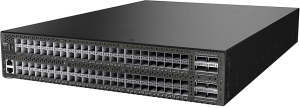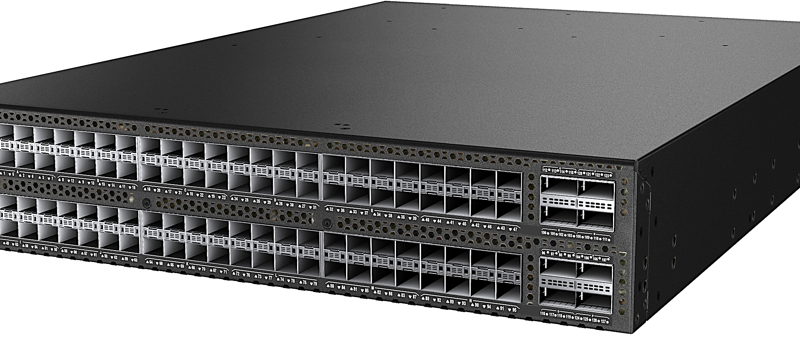Role & Functionality of SAN Fibre Channel Switches
As a systems administrator tasked with understanding your company’s storage area network (SAN), you may find yourself wondering: What exactly is the role of a fibre channel switch, and how does it function to keep data moving between storage and servers? Every SAN relies on switches as the intelligence behind the curtain. They manage discovery, zoning, virtual fabric construction, dynamic load balancing, QoS and much more—all without any direct intervention from you.
In this post, we’ll take a deeper look at the inner workings of these switches to help demystify their purpose and capabilities.

Easily Connected Fabric Topology
FC switches are arranged in a fabric topology that allows devices like servers and storage to easily connect and communicate. This fabric forms the backbone of the SAN, providing multiple redundant paths for data to traverse. Within the fabric, switches are interconnected using fibre-optic cables to enable pathway discovery and traffic routing. When you connect a server or storage array to the fabric using an adapter card, the attached switch instantly learns its location on the network.
Zoning Technology
Zoning allows administrators to logically separate devices on the fabric into zones, restricting traffic to only servers and LUNs that need to interact. When you assign devices to zones, this simplifies management while enhancing security. Only members of the same zone can see and access each other’s resources, avoiding potential interference or unauthorised access that could compromise data integrity. Zoning takes the guesswork out of connectivity and allows granular control over data accessibility.
Private Loop Operation
In a private loop, the SAN switches are daisy chained together without fabric connections between them. This ring topology sees a traffic loop in one direction around the continuous path. When data enters the loop from a connected server or array, it circulates until reaching the destination node. To you, this guarantees fast transfer speeds since only one switch handles each transfer instead of multiple hops. Private loops offer simplicity for smaller SANs with limited budgets.
Director/Edge Port Operation
Within a fabric, switches use different port types to route information. Director ports connect switches to form the internal mesh fabric. Edge ports attach servers, storage and other network resources to this infrastructure. The edge switch handles initial handshakes and inquiries before forwarding to the fabric core. When pulling resources, it knows which director port leads to the destination through its extensive routing table. In essence, edge ports represent your single point of presence on the SAN.
Adaptive Networking Capabilities
Modern-day SAN switches leverage adaptive networking capabilities for optimal performance. Features like congestion notification alerts dynamically realign traffic onto less-used paths. When you scale your infrastructure, bandwidth is continuously monitored to non-disruptively reallocate as utilisation changes across the fabric. This ensures high throughput is maintained even during peak demand cycles. Inter-switch links likewise support automatic failover if a routing path goes down to restore redundancy.
Inter-Switch Commands
In the background, FC switches utilise a host of inter-switch link (ISL) protocols for smooth operations. Link initialization periodically refreshes fabric hardware mapping tables. Exchange link parameters configure the connection characteristics. Registered state change notification alerts when devices are added or removed from the network. Simple name server queries track worldwide names to efficiently locate devices and LUNs on demand. Together, these commands automate fabric coordination behind the scenes.
Dynamic Load Balancing
One of the key advantages Fibre Channel brings is dynamic load balancing across all uplinks and routing paths. The switch determines the most direct egress port for each transaction based on current traffic levels to spread the workload evenly. When moving large datasets to backup targets or between servers, it balances transfers at wire speed for maximum throughput. With data stripping across links, performance scales linearly as your infrastructure expands in size.
Read/Write Operations
When reading or writing data, switches utilise different types of operations depending on the command structure. Common read commands include read buffer, recall and fabric bind. Writes leverage operations like write buffer and insertion for efficient data placement. Additionally, atomic operations guarantee read-modify-write sequences complete without interruption for consistency. Understanding these lower-level primitives gives insight into how switches seamlessly shuffle IO workloads at blazing speeds.
Hardware Acceleration
Modern FC switches leverage robust integrated circuits and dedicated hardware for high-speed transaction handling. With tools like TCP offload engines, the CPU remains unburdened from network housekeeping and can focus on higher-level orchestration. Application-specific integrated circuits (ASICs) accelerate frame forwarding, address lookups and traffic arbitration many times faster than software-based approaches. When megabytes become gigabytes and terabytes, hardware acceleration proves vital for linear scalability.
Built-in QoS Features
Quality of service features built into the switches help optimise performance based on priority and application needs. A controlled, lossless environment dedicates full bandwidth to critical storage workloads. Class-based shaping permits the division of connections into groups for tiered service levels. Markers identify business-critical data streams at the frame level for preferential treatment up the line. Advanced QoS tools provide elasticity to satisfy shifting workload demands over time.
Diagnostics and Monitoring
Comprehensive diagnostic tools provide visibility into fabric activities for issue discovery and capacity planning purposes. Port mirrors duplicate traffic for hardware monitoring, and virtual interfaces route selected streams to debugging tools. Extensive logging tracks event sequences to isolate bottlenecks. SFP/cable diagnostics identify physical failures before they escalate. Statistics gathering reports switch loads, throughput and port utilisation for long-term trend analysis. Non-intrusive monitoring helps pinpoint odd behaviour without disrupting production environments.
Management Options
FC switches support out-of-band or in-band management access over dedicated ports. Command-line interfaces allow direct configuration of zoning, trunking and parameters. Alternatively, browser-based graphical options present an intuitive point-and-click control panel. Third-party management software consolidates monitoring across entire estates for centralised visibility and control. Application programming interfaces further expose functionality via scripts and automation. Choosing the right option matches your skills and management style.
Conclusion
By now, you should have a solid understanding of how Fibre Channel switches power and coordinates modern SAN infrastructures. Their role spans defining the fabric topology, handling data transfers, optimising performance through load balancing and quality of service features, securing access through zoning, and more. With diverse management tools and built-in diagnostics, switches enable visibility and orchestration of massively scalable storage networks to reliably fuel today’s data-driven businesses. Remember these concepts as you continue to navigate and evolve your company’s storage environment.

